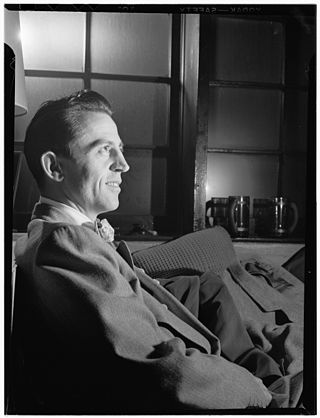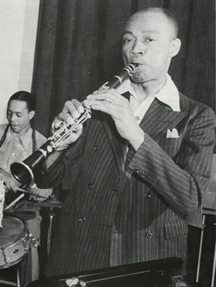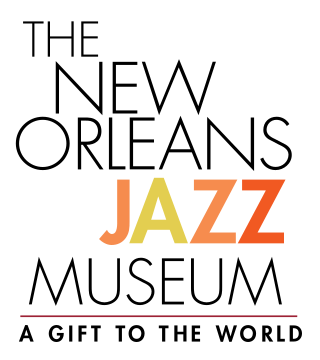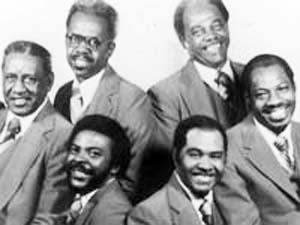
Dominic James "Nick" LaRocca, was an American early jazz cornetist and trumpeter and the leader of the Original Dixieland Jass Band, who is credited by some as being "the father of modern jazz". He is the composer of one of the most recorded jazz classics of all-time, "Tiger Rag". He was part of what is generally regarded as the first recorded jazz band, a band which recorded and released the first jazz recording, "Livery Stable Blues" in 1917.

Algiers is a historic neighborhood of New Orleans and is the only Orleans Parish community located on the West Bank of the Mississippi River. Algiers is known as the 15th Ward, one of the 17 Wards of New Orleans. It was once home to many jazz musicians Algiers frequently although dubiously bills itself as the second oldest neighborhood in the city.
Robert Franklin Palmer Jr. was an American writer, musicologist, clarinetist, saxophonist, and blues producer. He is best known for his non-fictional writing on the field of music; his work as a music journalist for The New York Times and Rolling Stone magazine; his production work for blues recordings ; and his clarinet playing as a member of the 1960s jazz band, the Insect Trust.
Thaddeus Bunol "Tad" Jones was an American music historian and researcher. His extensive research is credited with definitively establishing and documenting Louis Armstrong's correct birth date, August 4, 1901.

Boyd Albert Raeburn was an American jazz bandleader and bass saxophonist.

Edmond Hall was an American jazz clarinetist and bandleader. Over his career, Hall worked extensively with many leading performers as both a sideman and bandleader and is possibly best known for the 1941 chamber jazz song "Profoundly Blue".

The New Orleans Jazz Museum is a music museum in New Orleans, Louisiana, U.S., dedicated to preserving and celebrating the history of jazz music. Originally a separate museum, the collection is now affiliated with the Louisiana State Museum. The New Orleans Jazz Museum is located in the Old U.S. Mint building on 400 Esplanade Avenue, bordering the historic French Quarter neighborhood.

John Robichaux (1866–1939) was an American jazz bandleader, drummer, and violinist. He was the uncle of Joseph Robichaux.

Alcide Louis "Slow Drag" Pavageau was an American jazz guitarist and double-bassist.
Edmond "Doc" Souchon was an American jazz guitarist and writer on music. He was a pivotal figure in the historical preservation of New Orleans jazz in the middle of the 20th century.

"Livery Stable Blues" is a jazz composition copyrighted by Ray Lopez and Alcide Nunez in 1917. It was recorded by the Original Dixieland Jass Band on February 26, 1917, and, with the A side "Dixieland Jass Band One-Step" or "Dixie Jass Band One-Step", became widely acknowledged as the first jazz recording commercially released. It was recorded by the Victor Talking Machine Company in New York City at its studio at 46 West 38th Street on the 12th floor – the top floor.
Elizabeth Allison Miner was a music promoter and manager who was instrumental in the early production of the New Orleans Jazz & Heritage Festival and the later career of pianist Professor Longhair.

Howard-Tilton Memorial Library is the university library on the uptown campus of Tulane University in New Orleans, Louisiana. A member of the Association of Research Libraries, the Howard-Tilton Memorial Library is ranked among the top 120 research libraries in North America and is a significant educational and cultural resource in the community. During Hurricane Katrina, the Library suffered extensive damage to its collections and its buildings.

James Brown Humphrey, also known as "Professor Jim" Humphrey (1859–1937) was an American classical musician, dance band leader, and music instructor in New Orleans, Louisiana, and central figure in the formation of jazz as a contemporary musical art form. Humphrey predates the jazz genre as an active performer and is not himself considered a jazz musician. However, his involvement in the formal training of large numbers of musicians along the southern plantation belt of the Mississippi River delta during the immediate years following the reconstruction era resulted in many virtuoso performers who would go on to originate jazz as a distinct musical genre. Consequently, he is regarded by some in the jazz aficionado community to be "the grandfather of jazz".

Paul Crawford was an American jazz musician, music arranger, and music historian. He specialized in Dixieland jazz.
Susan Tucker is an American archivist. She was the Curator of Books and Records for the Newcomb Archives and Vorhoff Library at Newcomb College of Tulane University for over 30 years. She retired in 2015. She is a longtime member of the Society of American Archivists and is active in the Women's Collection Roundtable. She is now an archival consultant specializing in genealogy and family records.

Florence Edwards Borders was an American archivist, historian, and librarian. She specialized in the preservation of African American historical artifacts, especially those related to Afro-Louisianans.

Kevin J. McCaffrey is an American filmmaker, writer, editor, and oral historian based in New Orleans. His documentary and archivist work primarily focuses on Louisiana history and culture, with an emphasis on the region's culinary history and environmental issues. McCaffrey's work has received both national and regional recognition. He has worked with a number of notable organizations dedicated to preserving the history and culture of Louisiana and New Orleans, including New Orleans Jazz & Heritage Foundation, Louisiana State Museum, Historic New Orleans Collection, WYES-TV, Loyola's Center for Environmental Communication, and the Louisiana Folklife Commission.

The Zion Harmonizers is an American gospel music group founded in 1938 and based in New Orleans, Louisiana.


















